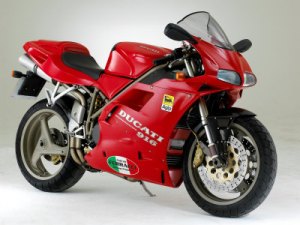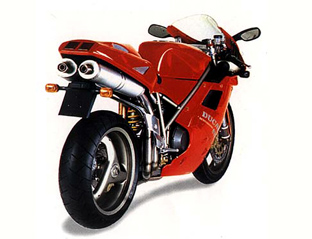To many, Ducati’s 916 is not merely a Superbike, but the Superbike. Part motorcycle, part fantasy, part erotic art, few motorcycles of the past 20 years has aroused such passion amongst the motorcycling public.
Just look at it. Is there such thing as Repetitive Strain Injury of the desire muscles? There is now. Within nanoseconds of its UK launch in late 1993, a whole generation of bikes had instantly put the 916 top of their list. Practically overnight, every one of the 200 destined for Britain in 1994 were sold, and the first 100 due in ’95. Even at $11,800 apiece, it seemed cheap.

Not only does the 916 have looks in abundance, it has pedigree. Essentially, it is a racer, with almost desultory addition of lights and a number plate. It is more than a spin-off from World Superbike regulations which insist that if you can’t find the same frame, engine castings and induction system in the shops, you can’t put them on the track, either. For this reason, Honda would probably never have built their RC45 were it not for their Superbike racing ambitions. Ducati, on the other hand, almost certainly would have built the 916 – because they are Italian and Italians are into that sort of thing.
The 916’s predecessor, the 888, had already won the World Superbike crown in 1990, ’91, ’92. Hot off the drawing board, the 916 followed suit, taking Carl Fogarty to memorable victory in the 1994 title chase. By the time you read this, he will probably have won it again. And if Fogarty doesn’t, another 916 almost certainly will.
Despite the leanness of its lines, the 916 is an extraordinarily complex box of tricks. That slim fairing hides an engine which may ‘only’ be a twin, the latest in a line of Ducati V-twin dating back to 1972. But the latest Dukes have four valves per cylinder, four camshafts, six gears, liquid-cooling, computer-controlled electronic fuel injection and desmodromic valvegear.

All this advance technology makes the 916 quite unlike most racing engines. Instead of a diet of pure, giddy revs, the twin pours out irrepressible, visceral urge almost from tickover. Solid, hard power begins as low as 3000 rpm, and from 6000 upwards the universe is thrown into reserve. Top speed is a blistering 160 mph.
In 955cc Superbike racing trim, the ‘916’ develops the thick end of 150 bhp. As a roadster it claims 114 bhp at 9000 rpm, but feels even stronger, more usable. The spread of power is so immense that almost any gear will do. And the booming roar when downshifting into corners is one of the joys of motorcycling.
The Ducati’s chassis, too, is of the highest class. Compared to the 888, the 916 is shorter, more agile, and more racer-like. The Japanese Showa suspension offers a huge array of setting, but there is very little wrong with the Duke straight out of the crate. With its short wheelbase and its lively geometry, it is in its element through turns – blindingly fast sweepers and hairpins alike.

Anyone buying the 916 takes custody of a dream as much as reality. As a practical street bike it has its faults, not the least of which is comfort. In a racing crouch – what it was designed for, all – it fits like a glove. As a tourer, it makes a good plank. This is not a practical motorcycle, and every red-blooded rider in the world should want one.
Filed under: Ducati | Tagged: advance technology, Ducati, Ducati 916, engine, Italian, motorcycle, racer, Superbike, World Superbike | Leave a comment »
 Any motorcycle capable of lapping the Isle of Man TT course at over 117 mph has got to be special. When the machine in question is a standard roadster, complete with lights, generator and pillion seat, and has since benefited from a further five years of development, it is clearly very special indeed. This is just part of the pedigree of Yamaha’s stunning FZR 1000.
Any motorcycle capable of lapping the Isle of Man TT course at over 117 mph has got to be special. When the machine in question is a standard roadster, complete with lights, generator and pillion seat, and has since benefited from a further five years of development, it is clearly very special indeed. This is just part of the pedigree of Yamaha’s stunning FZR 1000.




![honda_goldwing_2009_01[1]](https://supremebikes.files.wordpress.com/2010/05/honda_goldwing_2009_011.jpg?w=300&h=225)










